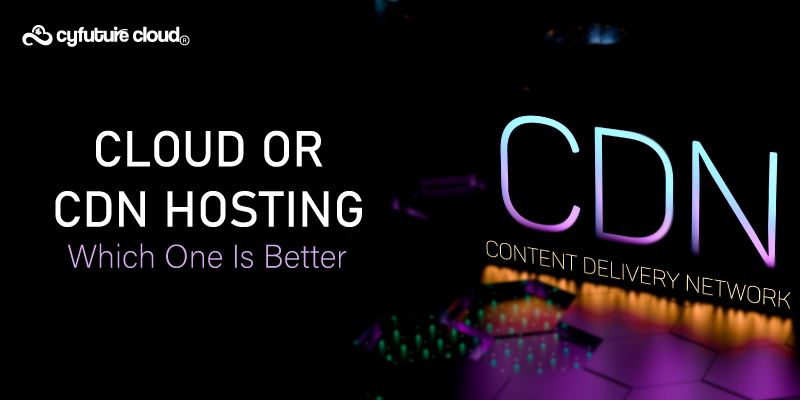 Server
Colocation
Server
Colocation
 CDN
Network
CDN
Network
 Linux Cloud
Hosting
Linux Cloud
Hosting
 VMware Public
Cloud
VMware Public
Cloud
 Multi-Cloud
Hosting
Multi-Cloud
Hosting
 Cloud
Server Hosting
Cloud
Server Hosting
 Kubernetes
Kubernetes
 API Gateway
API Gateway


The content universe on the internet is expanding rapidly and will double many times over in the next years. Consumers expect fast and secure data access on any device from any part of the world. Content providers need to find the solution to the challenges of delivering streaming and optimized content to computers, smartphones, and tablets. In this instance, frequent difficulties include increased scalability, greater quality of service, more capabilities, and increased security. Cloud computing and content delivery networks (CDN) are two widely used methods to address those problems.
What do they mean? How do they work? and when you may use them to meet your needs? The purpose of this essay is to compare and contrast cloud computing with CDN.
A dispersed network of servers and file storage devices is called a CDN. Files, music, video, and other types of material may all be duplicated across this network. on a large number of surrogate systems located at various geographical locations across the globe.
By lowering the latency of information delivery to its customers, content delivery networks (CDNs) enhance the scalability and quality of services provided on the internet. They are incredibly versatile. The CDNs do so by maximizing the bandwidth for accessing the data from clients throughout the network by strategically placing content replica(s) at geographically distributed locations.
It is more crucial than ever for content producers to comprehend the needs and desires of customers in the current changing online environment. Think of a video streaming service like Netflix or YouTube, for instance. When video material is sent to subscribers on different continents, the video experience might change based on the route used to reach the end user. A CDN takes care of this.
CDNs use a variety of strategies to enhance website speed and optimise content delivery. The essential elements of CDN operation are as follows:
Organizations can enjoy the following benefits when using CDNs:
Content Delivery Networks (CDNs) strategically store website content across multiple edge servers globally, optimizing retrieval by serving from the nearest server. This accelerates page loads, lowers latency, and ensures a more responsive user experience. Content caching not only improves performance but also lightens the load on the origin server, allowing it to focus on crucial tasks. The result is an optimized infrastructure capable of handling increased traffic volumes and delivering a smoother user experience.
CDNs ensure optimal content delivery worldwide by strategically placing edge servers, reducing physical distance and improving website performance. Businesses with global audiences benefit from CDNs, providing a consistent and satisfying user experience regardless of the user's location—be it North America, Europe, Asia, or anywhere else.
The way that CDNs distribute user requests among several edge servers is through load-balancing techniques. By preventing any one server from being overloaded with traffic, load balancing maintains high availability and peak performance.
CDNs make sure that user requests are processed quickly and effectively by intelligently spreading traffic. This lowers the possibility of server overloads and stops performance deterioration during traffic spikes. Furthermore improving fault tolerance is load balancing, which allows CDNs to automatically reroute requests to a different server in the event that one goes down or has problems.
The practice of hosting websites and applications on virtual servers that access resources from a network of physically connected actual servers is known as cloud hosting. Cloud hosting, in contrast to conventional hosting techniques, makes use of the resources of several servers to offer scalability, flexibility, and dependability.
For experts and companies engaged in website construction, cloud hosting has changed the game thanks to its many advantages over conventional hosting techniques. In order to select the best hosting option, it is imperative that you are aware of these advantages.
This section will highlight the key advantages of cloud hosting, as follows:
Businesses may instantly scale up or down their resources with cloud hosting based on their needs. To maintain optimal performance during periods of heavy traffic or increasing demand, more server resources might be dynamically deployed. Conversely, during periods of low traffic, resources can be scaled back, allowing businesses to optimize costs and avoid unnecessary expenses.
One important consideration in website hosting is reliability. Businesses may suffer from downtime, which may lead to missed sales and harm to their reputation. Cloud hosting's dispersed server network makes it exceptionally reliable.
Unlike traditional hosting solutions, which rely on a single physical server that could experience hardware problems or outages, cloud hosting distributes data and programmes over several servers. This distributed architecture ensures that the website or application will continue to function even in the case of a server failure by automatically moving resources to other servers that are available.
This redundancy gives enterprises a dependable hosting environment and drastically lowers the chance of downtime.
Cost-effectiveness is another significant advantage of cloud hosting. Conventional hosting techniques sometimes entail one-time expenditures for infrastructure, hardware, and upkeep. This can put a heavy financial burden on businesses, especially small or newly established ones with limited resources.
With pay-as-you-go cloud hosting, businesses may only spend money on the resources they actually require. Businesses may utilise cloud hosting services instead of investing in hardware like servers and infrastructure. This eliminates the need for an initial capital expenditure and reduces ongoing maintenance costs.
Furthermore, by only buying what they truly need, cloud-based servers allow organisations to save money by allowing them to adapt their resource levels in reaction to demand.

Let’s talk about the future, and make it happen!
By continuing to use and navigate this website, you are agreeing to the use of cookies.
Find out more


